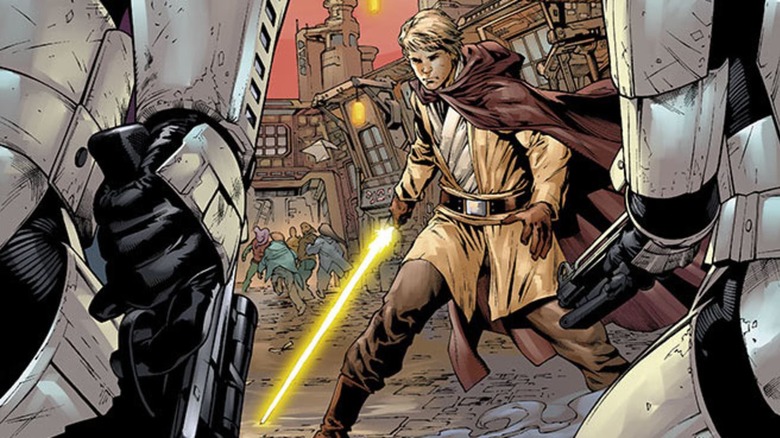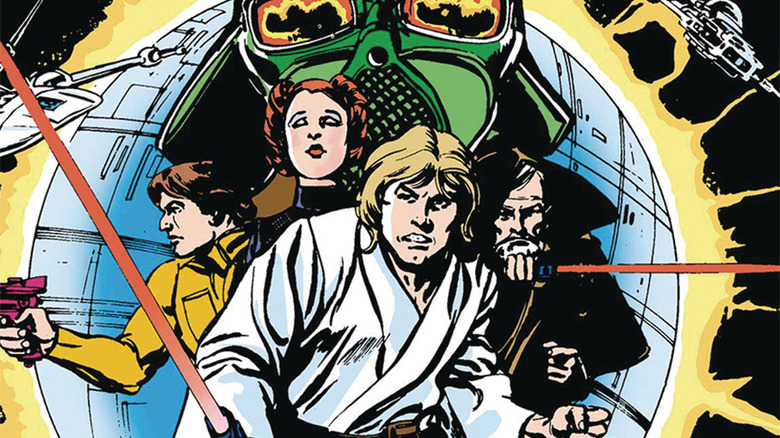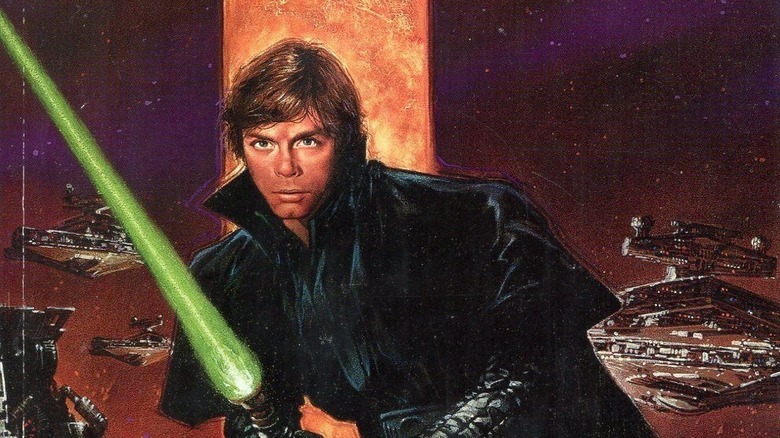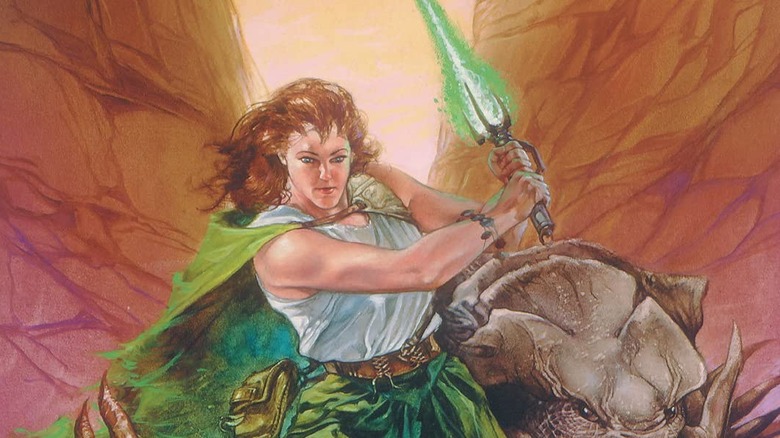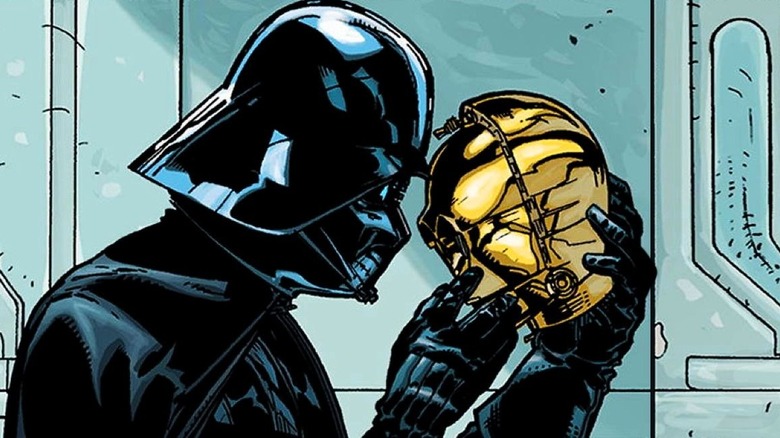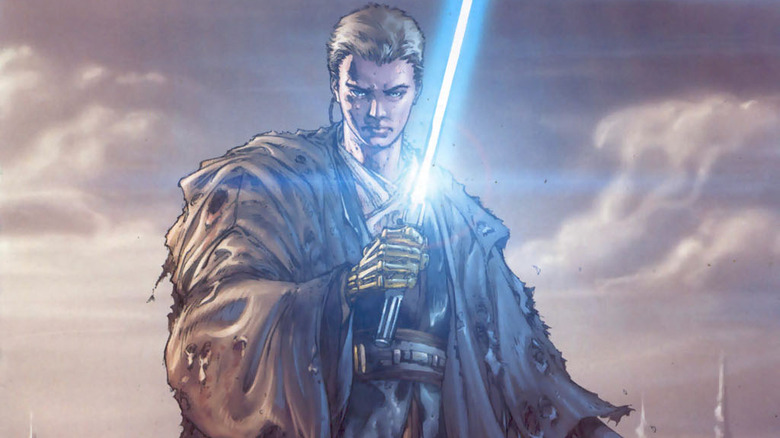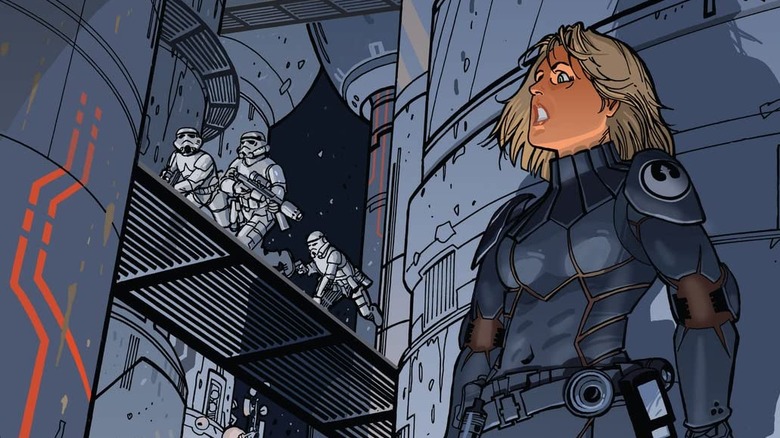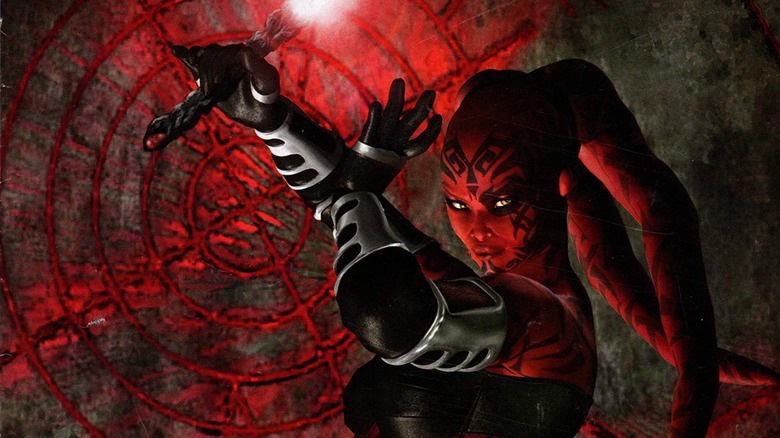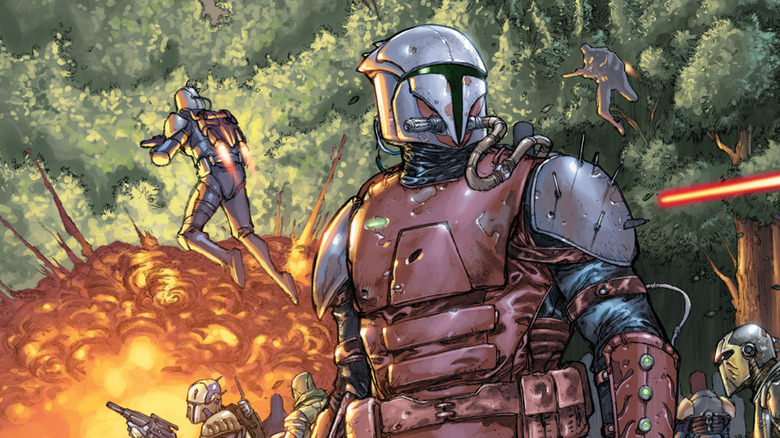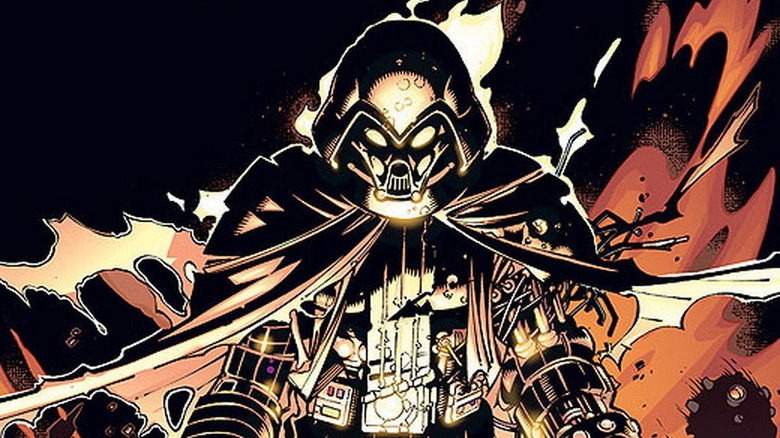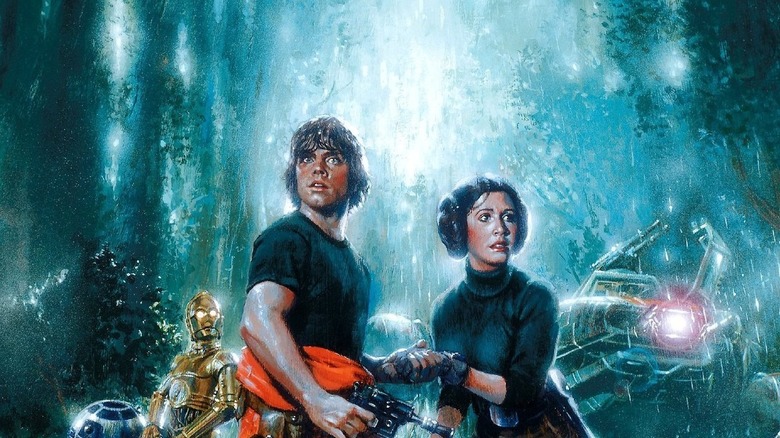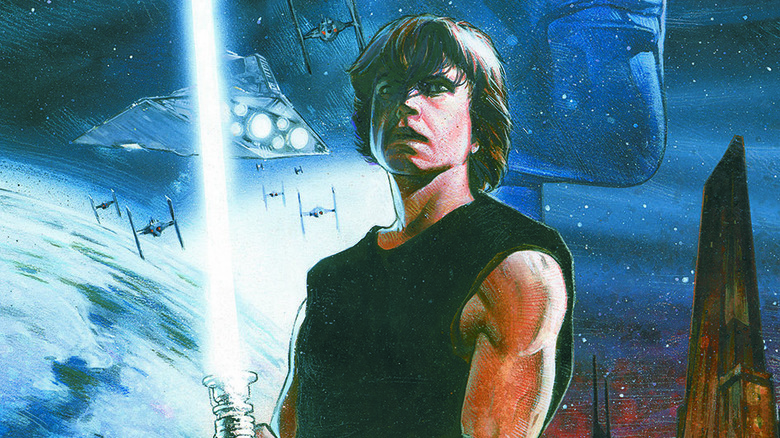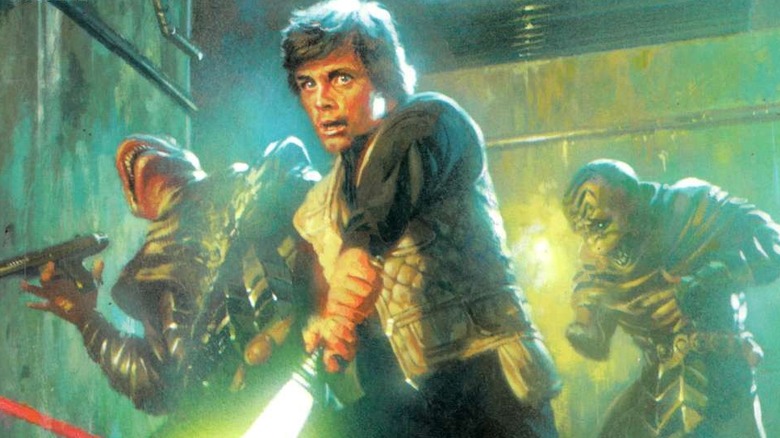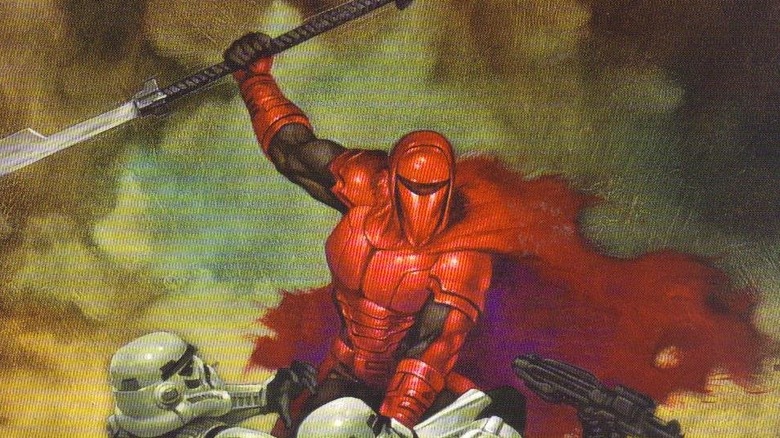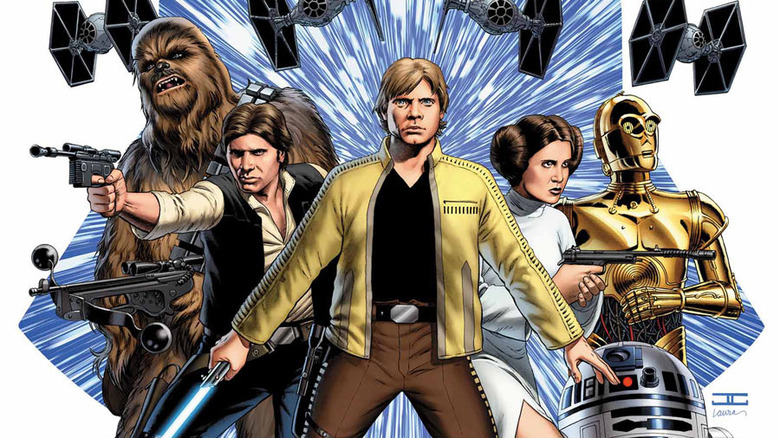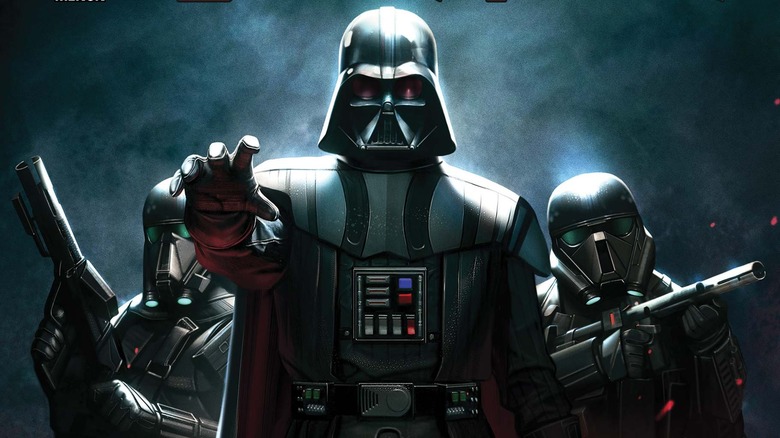The 15 Best Star Wars Comics You Need To Read
We may receive a commission on purchases made from links.
Ever since the original "Star Wars" hit theaters in May of 1977, creative artists outside of the film production team have been eager to tell stories set in a galaxy far, far away. The original "Episode IV: A New Hope" was adapted as a six-part Marvel comic book series by superstars Roy Thomas and Howard Chaykin, hooking fans with the teaser "Luke Skywalker: Will He Save The Galaxy or Destroy It?" The story continued beyond the first adaptation, continuing the adventures of Luke, Princess Leia, Chewbacca, Han Solo, C-3PO, and R2-D2 in the events leading up to "The Empire Strikes Back."
In 1991 the Expanded Universe was kickstarted when Dark Horse Comics took over the publishing rights to the universe. When Disney acquired Lucasfilm in 2012, Marvel Comics once again took over as the shepherd of "Star Wars" publishing, with the Lucas brand eventually launching a new official canon timeline. Are you a big "Star Wars" buff? Make sure to check out these comics!
Marvel's Star Wars (1977-1986)
Compared to the large amount of "Star Wars" content being released today, fans in the 1970s had far fewer options. In the wake of the first film's release new stories were scarce, and fans were eager to score any fresh content they could get their hands on. For many, the promise of a new monthly adventure on the pages of Marvel Comics' "Star Wars" series was the only dose of that galaxy they could get during the nearly unbearable three-year wait for "The Empire Strikes Back."
The original run of Marvel's "Star Wars" is one of the longest continuous series in the history of the franchise, releasing 107 issues between 1977 and 1986. Those issues took place between the releases of the first two films, while taking breaks to run the official adaptations of "The Empire Strikes Back" and "Return of the Jedi." The events after "Return of the Jedi" previewed many of the most important developments in the "Star Wars" universe, including the establishment of the New Republic and the now-prescient reveal that Boba Fett had survived the Sarlacc Pit. It even teased an early history of Mandalorians. The over-the-top art style is a stark contrast to anything else in canon.
Dark Empire
The year 1991 was very important in the history of "Star Wars" canon development. New "Star Wars" stories had been launched shortly after the release of "Return of the Jedi," including the animated series "Droids" and "Ewoks," as well as the live-action "Ewok" spinoff television films, but by the end of the decade "Star Wars" was mostly quiet. In 1991 several projects were released that explored events after "Return of the Jedi," including Timothy Zahn's novel "Heir to the Empire" which introduced Grand Admiral Thrawn, while Dark Horse also launched their slate with the "Dark Empire" comic book series.
"Dark Empire" opens with a shocking twist: Emperor Palpatine was able to survive the destruction of the second Death Star by transferring his soul to a clone body, a plot point that would later inspire "Star Wars: The Rise of Skywalker." Palpatine amasses a new Imperial fleet and aims to wipe out the beginnings of the New Republic, which has only recently been expanding. In a shocking turn of events, Palpatine is briefly successful in courting Luke Skywalker to join the dark side and become his new apprentice, although Luke is later brought back to the light side by his sister Leia, who has begun her Jedi training.
Tales of the Jedi
Throughout the history of the "Star Wars" canon fans have been fascinated by the ancient stories of Jedi and Sith that take place thousands of years prior to anything in the Skywalker saga. Prior to the invention of the "Rule of Two," Sith lords amassed in large numbers and grew their own epic order that faced off against the Jedi in massive battles. The timeline of the Old Republic Era has introduced many different storylines focused on different sets of new characters, but the "Tales of the Jedi" Dark Horse series from the '90s explored a schism within the Jedi Order itself.
The series primarily focuses on the Jedi Knights Exar Kun and Ulic Qel-Droma, who turn to the dark side of the force and become the new dark lords of the Sith. After attempting to take down the Galactic Republic, a band of Jedi heroes (including the fan-favorite Nomi Sunrider) are able to defeat Exar Kun and strip Ulic Qel-Droma of his force abilities. Droma eventually makes a gradual path towards redemption, but Kun would continue to cause havoc for future generations of Jedi. His Sith spirit becomes trapped on Yavin IV, the site of the eventual Rebel base and where Luke Skywalker sets up his new Jedi Academy. Ultimately, a young Anakin Solo and his friends must face off against Kun's evil spirit as he seeks to possess them.
Star Wars Tales
The Dark Horse era of comics introduced many new and ambitious elements to the saga, and the "Star Wars Tales" series is one of the most unique entries in the entire canon. Unlike other continuous storylines, "Star Wars Tales" was an anthology series that explored one-shot stories set throughout the timeline. Some of these one-shots were comedic in nature, such as the parodical "Skippy the Jedi Droid," or the ongoing adventures of Tag and Bink, two wacky rebel spies whose misadventures somehow manage to correspond to key moments in the original trilogy.
Some of the one-shots were more serious in nature, and few were as acclaimed as Ryder Windham's "Thank the Maker." The issue takes place within the events of "The Empire Strikes Back" when Darth Vader discovers the blasted body of C-3PO in Cloud City. Thinking back to his childhood where he created the droid, Vader has a brief moment of reflection.
Republic
In the lead-up to "The Phantom Menace," Lucasfilm was eager to tell a new set of stories that would introduce fans to the universe of the prequel trilogy. Like the classic Marvel comics of the '70s and '80s, Dark Horse's "Star Wars: Republic" series filled in the gaps of events that took place before, between, amidst, and after the three films in the prequel trilogy.
Beginning in 1998, the "Republic" series launched with a storyline set on Tatooine that followed the Jedi Council member Ki-Adi-Mundi (played by Silas Carson in the films). Ki-Adi-Mundi searches for the Jedi Shared Hett, who had abandoned the Order to live as a Tusken Raider and train his son, A'Sharad, as his apprentice. Mundi is tasked with bringing A'Sharad back to Coruscant, but the two must join forces in order to combat the force-sensitive bounty hunter Aurra Sing.
Following the release of "Attack of the Clones" in 2002, the "Republic" series became the main "Clone Wars" comic and chronicled the war effort from the perspective of characters like Count Dooku, Yoda, Mace Windu, Anakin Skywalker, Obi-Wan Kenobi, and Kit Fisto. The rogue Jedi Quinlan Vos and Sith acolyte Asajj Ventress were prominent characters. When the Republic crumbled in "Revenge of the Sith," the "Republic" series continued as "Dark Times."
Rebellion
Amidst the plethora of prequel stories released in the early 21st century of "Star Wars" publishing, Dark Horse's "Star Wars: Rebellion" series returned the story back to the events of the classic trilogy. Exploring similar storylines to those of the classic Marvel comics, the new Dark Horse series chronicled events between "A New Hope" and "The Empire Strikes Back" in which the Rebel Alliance is dealing with the aftermath of the Death Star's destruction. Darth Vader has, of course, become obsessed with finding the identity of the pilot who destroyed the critical battle station.
"Rebellion" explored an interesting period of adjustment for the classic heroes. Han and Leia have a burgeoning — yet unfulfilled — romantic attraction to each other, and Luke struggles with his new responsibilities as he is thrust into a leadership position without a Jedi mentor to look up to. Luke also has a romantic relationship with the new Rebel hero Deena Shan.
Legacy
"Star Wars: Legacy" was one of the most shocking comics in canon history, as the dark and complex storyline ventured further out in the "Star Wars" timeline than any other installment. The series is set over 130 years after the events of "Return of the Jedi" and introduced a brand new set of never-before-featured characters, with the exception of Luke Skywalker's force ghost. The Jedi Temple suffers an attack in the first issue that sparks a new war across the galaxy, and the Jedi are forced to go into hiding. The Sith are able to overtake Coruscant and once again rule the galaxy.
The main villain Darth Krayt has abandoned the "Rule of Two" and created the "One Sith," an order of Sith lords that are loyal to him. Luke Skywalker's descendant Cade had trained as a Jedi apprentice prior to the attack, but during the new Jedi purge Cade abandons the ways of the light side and becomes a bounty hunter alongside his allies Delilah Blue and Jariah Syn. However, Cade is ultimately called back to his destiny and must continue his family legacy and bring balance to the force.
Knights of the Old Republic
The "Star Wars: Knights of the Old Republic" video game series became a very popular new entry through the introduction of Darth Revan and Darth Malak. However, Dark Horse's "Knights of the Old Republic" explored a slightly different era within the "Star Wars" canon. In a period where the Sith have temporarily become dormant, the popular comic book series follows a conspiracy within the Jedi Order itself.
A young padawan named Zayne Carrick discovers that a conclave of Jedi padawans has been brutally murdered by several Jedi Masters. Zayne is shocked to discover the tragedy, but he becomes a fugitive when the Jedi Council blames him for the events and forces him to flee. Zayne searches the galaxy for answers with a new band of allies. The "Knights of the Old Republic," "Republic," "Rebellion," and "Legacy" comics were all featured in the crossover event "Vector."
Infinities
When Disney took hold of the rights to "Star Wars" in 2012, a new canon timeline was introduced and a vast majority of Expanded Universe stories were deemed non-canon then reframed into the "Legends" timeline. However, some of the early Expanded Universe stories were non-canon from the beginning, and no more obviously so than the "Star Wars: Infinities" series. Essentially the "Star Wars" version of Marvel's "What If?," the series explores alternate versions of each of the original trilogy films in which a change to one of the key events causes the story to go in a radically different direction.
In "Infinities: A New Hope," Luke misses the shot to destroy the "Death Star" and the Rebels go into a dark period after Vader captures the Rebel base on Yavin IV and kidnaps Leia. In "Infinities: The Empire Strikes Back," Luke dies on the snowy plains of Hoth, and it is Han and Leia who must venture to Dagobah to seek out Yoda. In "Infinities: Return of the Jedi," the plan to rescue Han Solo from Jabba the Hutt goes terribly wrong and Boba Fett escapes with the bounty. The end of the third installment is reimagined, with Palpatine escaping death on Death Star II and Vader also left alive to join the Rebellion in a white-clad armor suit.
Splinter of the Mind's Eye
"Splinter of the Mind's Eye" was the first "Star Wars" spinoff novel, released in 1978. Penned by Alan Dean Foster, who also ghost-wrote the official adaptation of the first film, the book has a very interesting history. In the case that "Star Wars" bombed at the box office, George Lucas planned to make a low-budget sequel that could be quickly put into production to use the previously existing sets and costumes. Harrison Ford had yet to sign a contract to return, and so Han Solo is not featured, and a majority of the events take place on a murky planet that would be easy to shoot. Lucas even cut a space battle from Foster's story that would be too expensive to film.
However, when "Star Wars" became the box office and cultural sensation that it was, Foster's script became a popular novel. The tale takes place shortly after the destruction of the "Death Star" when Luke and Leia travel to the planet Mimban in search of a Kyber Crystal. Luke and Darth Vader have a lightsaber duel for the first time in "Star Wars" history. Foster's story was later adapted as a comic book series in 1996.
Heir to the Empire
Timothy Zahn's "Thrawn Trilogy" of novels (including 1991's "Heir to the Empire," 1992's "Dark Force Rising," and 1993's "The Last Command") were a game-changing series that relaunched "Star Wars" books for the first time in a decade. These novels took place shortly after the events of "Return of the Jedi," where the New Republic struggles to suppress emerging Imperial remnants. A new threat comes to light when the Chiss Grand Admiral Thrawn unites the remaining Empire loyalists for a new war.
The novels notably introduced the character of Mara Jade, a former trainee of Emperor Palpatine who has now taken employment as a bounty hunter. Mara Jade is forced into an unlikely alliance with Luke Skywalker, and gradually they develop a romance that would be expanded on in subsequent stories. Thrawn would become one of the most popular "Star Wars" villains ever, and he eventually made his way into the new canon thanks to appearances on "Star Wars: Rebels." Dark Horse adapted the three books into a comics series beginning in 1996.
Shadows of the Empire
The year 1996 was important for Lucasfilm, as Hasbro had taken the rights to "Star Wars" action figures and begun releasing toys again in 1995. The Special Edition re-releases of the classic trilogy were planned for 1997, and production on "The Phantom Menace" had also jump-started. Lucasfilm needed a major event in 1996, so they created a "movie without a movie." The "Shadows of the Empire" project told one connected story across a novel, comic book series, video game, junior novelization, official soundtrack, roleplaying game, and merchandising line.
"Shadows of the Empire" bridges the gap between "The Empire Strikes Back" and "Return of the Jedi" where the Rebels search for Han Solo. It introduced a new smuggler, Dash Rendar, who helps Luke, Leia, and Lando search for their lost friend, who happens to be an old rival of Dash's. The new villain Prince Xizor is introduced as the leader of the Black Sun crime syndicate, and aims to replace Darth Vader as Emperor Palpatine's second-in-command.
Crimson Empire
One of the questions that fans left "Return of the Jedi" asking is who the mysterious Royal Guards who protected Emperor Palpatine were. Not much was known about these mysterious warriors until the "Star Wars: Crimson Empire" series took the time to explore the history of these men. Set after the events of "Return of the Jedi," "Crimson Empire" looks at how the Royal Guards have essentially been disbanded after failing to protect Palpatine. One survivor, Kir Kanos, has survived and now makes his way as a bounty hunter.
Kanos was betrayed by his former ally and fellow Royal Guard Carnor Jax, leading to a schism within the remaining Guards. Flashbacks to Kanos and Jaxs' training explore the secret academy in which the Emperor's protectors learn to use their weapons, and many are slain by Darth Vader himself during the initiation process to determine their strength. "Crimson Empire" debuted in 1997, and the sequel "Crimson Empire II: Council of Blood" began in 1998. The trilogy was finally concluded in 2012 with "Crimson Empire III: Empire Lost."
Marvel's Star Wars (2015-Present)
After the 2012 Disney takeover of Lucasfilm, "Star Wars" comics left Dark Horse and returned to their original home at Marvel Comics. Marvel decided to launch its flagship series as an ode to the original comic book run of the '70s and '80s. Simply named "Star Wars," that series explores the events between "A New Hope" and "The Empire Strikes Back" and once again primarily focuses on Luke Skywalker, Princess Leia, Han Solo, Chewbacca, R2-D2, and C-3PO.
Luke's character arc is the main focus of the new "Star Wars" series. Luke has anxieties about everything that he's gone through, and he's only now completely processing leaving Tatooine, losing his family and his mentor, and the weight of responsibility that comes with destroying the Death Star and being hailed as a Rebel hero. Luke wonders if it was just a lucky shot, or if he's really destined to be a Jedi after all.
Darth Vader
One of the most exciting ongoing series within the new era of Marvel Comics publishing is the "Star Wars: Darth Vader" series that explores the Dark Lord of the Sith's exploits between "The Empire Strikes Back" and "Return of the Jedi." Vader has come to question his role in the galaxy, as he desperately searches for any information he can gather on his son Luke. Emperor Palpatine has put even more pressure on him to wipe out the Rebel Alliance for good and convince his son to turn to the dark side of the force.
The new "Darth Vader" series does a great job at pulling in events from throughout the "Star Wars" canon to explore Vader's journey. Memories of Naboo and Padme Amidala return to him, and the series previews Emperor Palpatine's development of cloning technology on Exegol. The series also crossed over with the "War of the Bounty Hunters" event exploring Vader's relationship with Boba Fett. The current Marvel series has run for three volumes: "Dark Heart of the Sith," "War for the Bounty Hunters," and "Crimson Reign."
